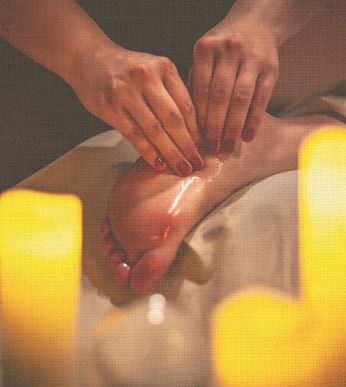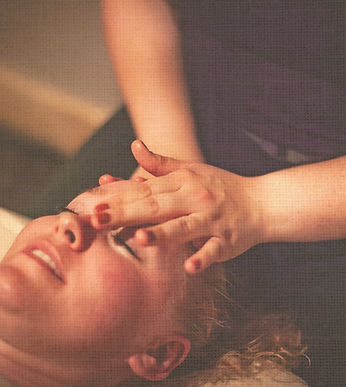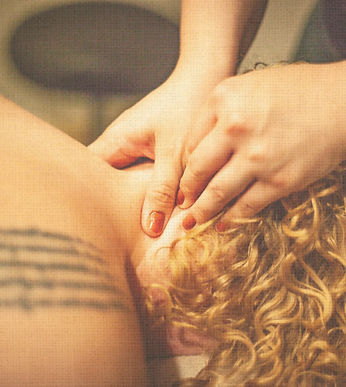Services
At Sol Rise Massage, session prices are based on time + enhancements. To create a tailored experience for all clients, modalities are mixed and matched based on need in the massage room. Please explore the Modalities and Enhancements sections below.
Swedish Massage
Swedish massage is perhaps the most popular and widely practiced form of therapeutic massage. It is characterized by the use of long, flowing strokes, kneading and squeezing the muscles, and the use of friction and tapotement (rhythmic tapping). The massage therapist typically uses oil and lotion to glide across the skin. These techniques are designed to relax the muscles, improve circulation, soothe the nervous system, and promote overall well-being.
Swedish massage is soothing in nature. The primary goal of Swedish massage is to enhance the body’s overall healing

processes and reduce stress. Clients are strongly encouraged to communicate their pressure preferences before and during each session.
Myofascial Release
Myofascial release is a therapeutic technique that addresses issues related to fascia (a connective tissue that surrounds and supports muscles, bones, and organs throughout the body). Fascia can become tight, restricted, and develop adhesions–this can lead to discomfort, pain, and limited range of motion.
Myofascial release is based on the concept that restrictions in the fascial tissue affect the entire musculoskeletal system. During a myofascial session, the practitioner applies gentle, sustained pressure to tight and restricted fascial areas with their hands, fingers, or other specialized tools. The goal of

myofascial release is to release tension and restrictions in the fascia to alleviate pain, improve mobility, and enhance overall physical function.
Myofascial release sessions are tailored to each client's individual and specific needs. Clients are strongly encouraged to communicate with the practitioner before, during, and after the session about their subjective experiences. Pressure can vary, and myofascial release may feel uncomfortable but should never be painful. You will discuss this with your practitioner when you come in for your session.

Pre and Post Natal Massage
During pregnancy, a person's body undergoes significant changes, often leading to discomfort and stress. Pre-natal massage helps alleviate common pregnancy-related issues such as back pain, swollen ankles, and leg cramps. By improving circulation, massage reduces edema (swelling) and enhances oxygen delivery to both mother and baby. The gentle, soothing touch of massage also helps reduce stress hormones while increasing serotonin and dopamine levels, promoting relaxation and emotional well-being. This not only benefits the mother but also creates a calm and nurturing environment for the baby.
After childbirth, a person's body requires time to heal and recover from the physical and emotional demands of pregnancy and labor. Post-natal massage aids in the recovery process by relieving muscle tension, especially in areas like the shoulders, neck, and back, which may become strained from breastfeeding and caring for a newborn. It also helps restore the body's natural alignment and reduce the discomfort associated with hormonal fluctuations. Additionally, post-natal massage can assist in reducing the appearance of stretch marks and improve skin elasticity. Emotionally, it provides a sense of relaxation and stress relief, helping new mothers manage postpartum depression and anxiety.
Lymph Drainage
Manual Lymph Drainage (MLD) is a gentle, therapeutic massage technique that focuses on stimulating the body’s lymphatic system, which is crucial for removing toxins, waste, and excess fluids from the body. Unlike traditional massage, MLD uses light, rhythmic strokes that follow the natural flow of the lymphatic system, helping to clear blockages and encourage the movement of lymph fluid.
During an MLD session, the therapist will use gentle, circular motions on the skin, starting from the neck and moving to other parts of the body. The

experience is deeply relaxing, often described as a soothing, meditative process that promotes a sense of well-being.
The benefits of MLD are extensive. It is particularly effective in reducing swelling (edema) and can be a key component in managing conditions like lymphedema. MLD also helps to detoxify the body, improve immune function, and enhance circulation. Additionally, it can relieve chronic pain, reduce inflammation, and accelerate healing after surgery or injury. For those seeking a non-invasive way to improve overall health and well-being, MLD offers a powerful yet gentle approach to enhancing the body’s natural healing processes.

Acutherapy
Acutherapy is a lighttouch therapy that is excellent for people who are not suited for pressure on the tissues. It is administered using a series of touch points on the body. Pressure is typically no more than the weight of a nickel.
This therapy is deeply calming and relaxing for the nervous system. It can support energetic and emotional release, and can aid healing.
Cranial Sacral Therapy
Cranial Sacral Therapy (CST) is a gentle, non-invasive form of bodywork that focuses on the craniosacral system, which includes the membranes and fluid surrounding the brain and spinal cord. The therapy is based on the concept that subtle movements of the cranial bones and the flow of cerebrospinal fluid influence overall health.
During a CST session, the practitioner uses light touch, often no more than the weight of a nickel, to evaluate and release restrictions in the craniosacral system. The

therapist may gently place their hands on the head, spine, or sacrum, working to relieve tension and promote the body’s natural healing processes. This subtle approach allows the body to correct imbalances that contribute to a variety of health issues.
Cranial Sacral Therapy is known for its wide range of benefits. It can help alleviate chronic pain, migraines, and tension headaches by releasing pressure in the head and spine. CST is also effective in treating conditions like TMJ (temporomandibular joint disorder), sinus issues, and even stress-related disorders. Additionally, it supports the nervous system, enhancing overall well-being and reducing symptoms of anxiety and depression. For those seeking a holistic, gentle approach to health, CST offers profound and lasting relief.

Lifting the Superficial Fascia
A personal favorite of mine! This therapy is used to help straighten out the posture. it is administered by a series of downward strokes along the back of the body and upward strokes applied to the front of the body. The pressure is similar to a swedish massage, but very little oil is used. This session is only available in 60 minute sessions.
Deep Tissue
Deep tissue massage is an extension of Swedish massage. It involves the use of the same techniques–flowing strokes, kneading and compressing, friction, and tapotement–to achieve massage goals.
Deep tissue focuses on addressing chronic tension, tightness, and knots in the deeper layers of muscles and connective tissue. This type of massage is designed to release chronic patterns of tension that are often caused by repetitive motions, old injuries, and poor posture.
Deep tissue massage moves at a much slower pace than a typical Swedish massage. It is critical to warm the superficial tissues in order to affect the deeper tissues without causing harm. The practitioner may use their elbows, forearms, or knuckles to apply sustained pressure. These techniques aim to break down adhesions and realign muscle fibers.


.png)
.png)